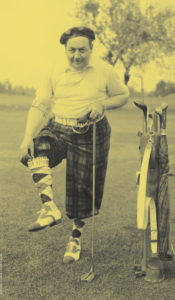 Picture a chilly, foggy Scottish morning and a couple of Highlanders batting the first golf ball around. No one has a photograph, but you can bet they were sporting traditional Scottish kilts. This didn’t last long however, because by the year 1600 the gentry and royalty had taken up the game, and full dress was the order of the day. This meant long pants, jackets and ties for the gents; and bonnets, petticoats, girdles, full skirts and tailored blazers for the ladies. It is totally difficult for the Golf Guy to imagine anyone able to take a full swing at a golf ball in such attire. But, swing they did because the game persisted and the fashion remained static for the next 300 years.
Picture a chilly, foggy Scottish morning and a couple of Highlanders batting the first golf ball around. No one has a photograph, but you can bet they were sporting traditional Scottish kilts. This didn’t last long however, because by the year 1600 the gentry and royalty had taken up the game, and full dress was the order of the day. This meant long pants, jackets and ties for the gents; and bonnets, petticoats, girdles, full skirts and tailored blazers for the ladies. It is totally difficult for the Golf Guy to imagine anyone able to take a full swing at a golf ball in such attire. But, swing they did because the game persisted and the fashion remained static for the next 300 years.
The marvelous thing about this period was your wardrobe never went out of style. It would have sent today’s fashion designers into a state of apoplexy to know that the styles would remain frozen for centuries. Ah, but change they finally did, and in the early 1920s men were permitted to remove their jackets. The shirts and ties stayed, but knickers and long socks became the rage. The 1920s saw a giant fashion leap forward for the golfing gals. Gone were the petticoats, girdles and bonnets, to be replaced by the newest vogue, simple straight skirts and sweaters, and the bonnets lost out to flapper-style bucket hats.
For the first time, clothing manufacturers were catching on to the fact that there were profits in this niche industry, and began designing clothing for the golf course. Names such as Golfflex, Fleisher Yarns and Gossard became must-have labels on the links.
Things remained somewhat the same for the next 20 to 30 years with just minor adjustments to keep industry sales current. And it is important to remember that women simply never wore pants of any kind whatsoever until World War II and the advent of Rosie the Riveter. Post WWII saw the golf attire industry explode to the billions of dollars it encompasses today.
The next 50 years saw the introduction of such names as Callaway, Adidas, Nike, Under Armour, Ashworth, Cutter & Buck, Antigua, Greg Norman, Bobbie Jones and Jamie Sadock to name just a few. And this list does not cover the clothing giants such as Ralph Lauren and Izod, who cross over with their own lines of golf clothing. Nor does it take into account such designers as Lilly Pulitzer and Lulu Lemmon, whose lines are not specifically marketed for golf but are worn on the course with increasing popularity. With all of these fashion players now in the fray it’s no wonder that the styles have been in a constant state of flux since the big war.
In the late 1940s and early 1950s the men’s knickers and long socks finally gave way to long pants, or slacks as they were then called. But it was not until later on in the 1960s that these slacks started showing traces of color. Then in the 1970s, men’s golf attire went full-blown weird. Bell-bottom slacks in hideous bright colors with equally bright leisure-styled, spread-collar shirts dominated the links. It was absolute proof that man is a herd animal and if you dress the alpha male in anything the pack will follow suit. The problem with this craze is that it lasted well into the 1980s.
Finally mankind got a grip on itself, or maybe actually looked at themselves in a mirror and the nonsense ended and the players returned to a more conventional style—except for Payne Stewart who went retro and donned his signature colorful knickers and vest.
Purchase an issue to continue learning about the history of golf fashion.
